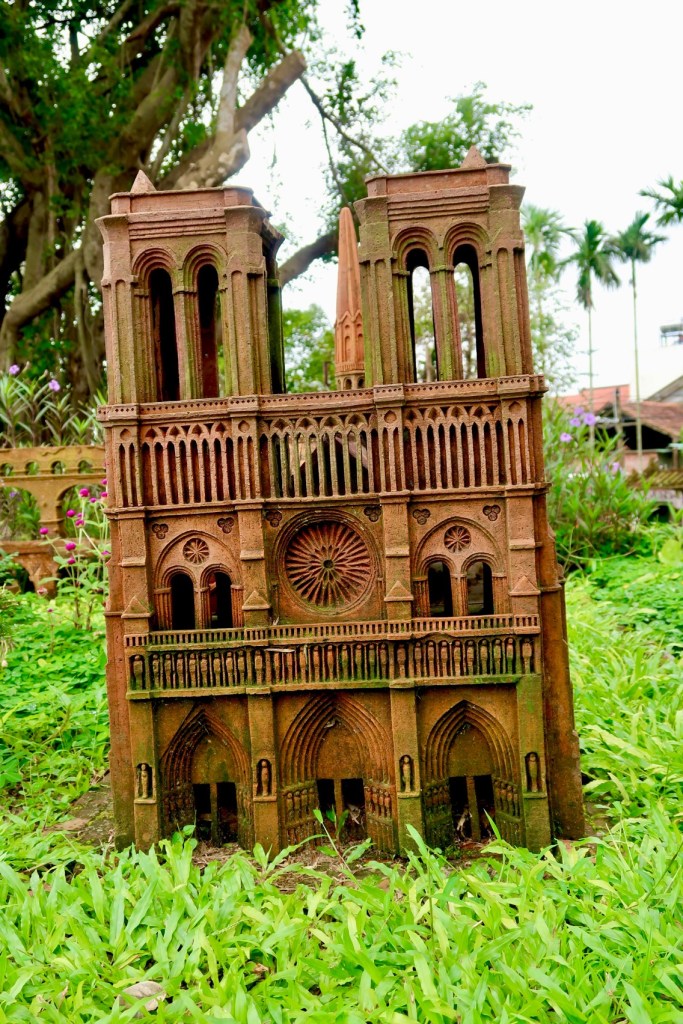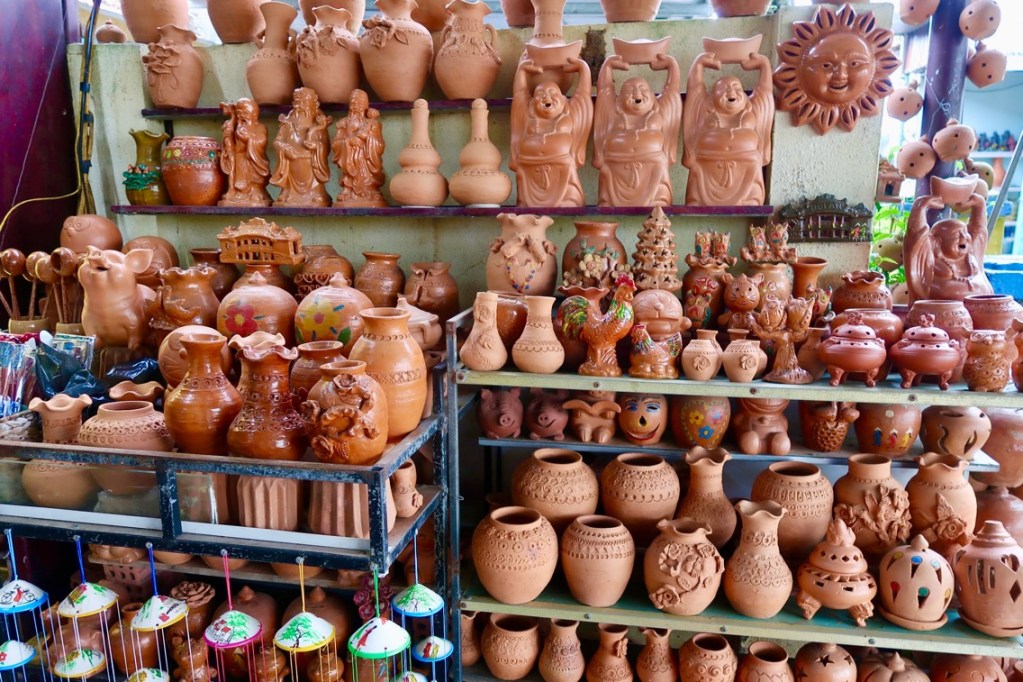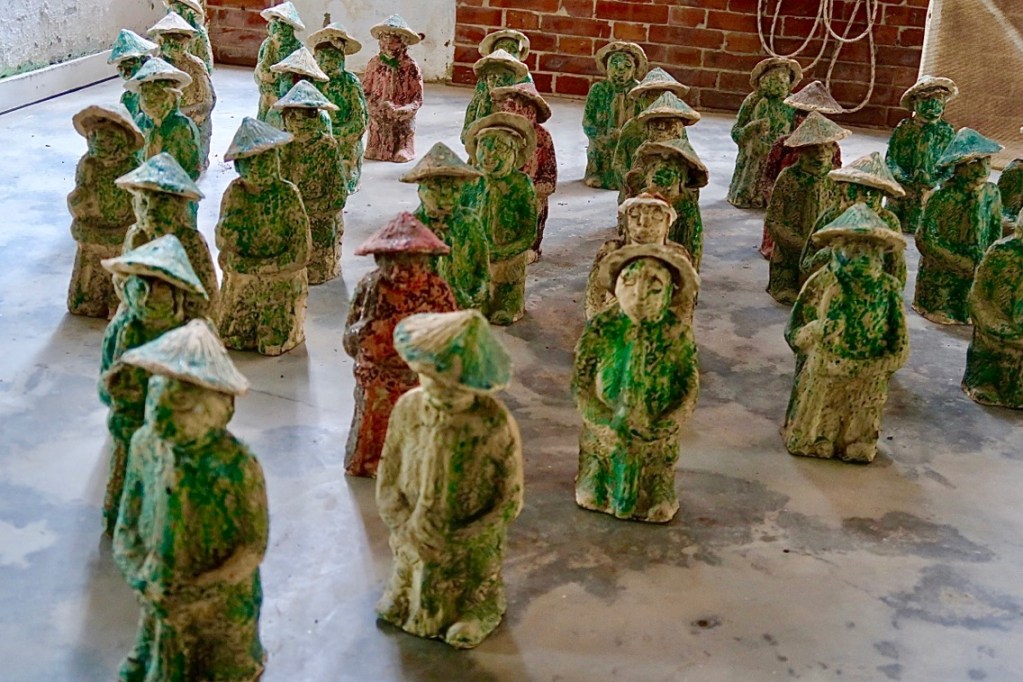Thanh Ha Pottery Village, Hoi An, Vietnam














































































Thanh Ha Pottery Village, Hoi An, Vietnam
We had made plans to cycle to the beach while staying in Hoi An, and along the way to see the surrounding countryside.
But the weather did not cooperate with our plans.
It rained almost every day that we were in Hoi An, and even when it did not rain, it was windy and cloudy, which did not feel like the best weather to enjoy the beach.
So instead of a cycling day to the beach, we walked over to visit an old pottery village called Thanh Ha.
We could have borrowed the free bicycles offered by our hotel, but the pottery village is located only 4 kilometers away, and we wanted to get more physical exercise.
The walk along the river was scenic.
The river was flowing very high, but was not flooding the road we were walking on.
The morning fish market in Thanh Ha had just ended, and vendors were packing away flowers, vegetables and whatever seafood had not sold.
Men wearing gumboots were hosing down the meat and seafood stalls, and ladies with conical hats were sweeping the ground with bamboo brooms.
There is a small ticket booth at the entrance to the pottery village. A ticket cost only $1.50, and it allows you to visit any home that makes pottery or any pottery workshop and try your hand at spinning the potters wheel to make your own terracotta pot or vase.
Most of the pottery that is made in this village is made from terracotta clay, which is what can be found on the banks of the river here.
According to legend, about 400 years ago a group of traders were going to the South of Vietnam via the river when their boats encountered a strong storm.
They moored their boats at one of the 13 hamlets of Thanh Ha village, where the water was calm.
This charming waterway captured their hearts and they decided that they did not need to search for a new home anymore.
They put down roots by the river and founded this village.
The village is a small cluster of very narrow streets, lined with ramshackle houses by the riverside.
The houses are all made of wood, and some look old and rickety.
The river overflows the village’s streets every few years, and the locals fix their old houses and repair or reconstruct after the flood damage.
The villagers remain happy with living so close to the river, because they get their clay from the banks of the river, and they also use the river to ship their pottery products and raw materials.
Apart from pottery, the villagers also build boats and go fishing for their livelihood.
There are a few small cafes and places selling snacks and small pottery shops at the front of a few of the homes, and they have pottery kilns in their back yards.
We saw two women working together to operate a kick pottery wheel.
One was standing and kicking the pottery wheel with her bare foot, while the other woman was sitting down shaping the pots.
The kilns were very simple ovens, made of red brick.
Again, it is hard to envision a prosperous time in this small village, but during the 17th and 18th centuries when Hoi An was a bustling trading port with a big population, the pottery of Thanh Ha Village was in high demand.
Bowls, pots, cups, jars, teapots, and other items created here were both cheap and durable.
The entire production process was always done by hand.
The clay is mined from the Thu Bon riverbed, and then cleaned and kneaded.
The clay is placed on a turntable run by two artisans.
After shaping, the pottery is left to dry in the sun and then it is trimmed again if necessary.
The ceramic is then dried for a second time in order to stiffen it.
Finally, the pottery is fired in the kiln for two days and two nights.
At every house that we passed in the village, the people were eager to greet us and asked us to come in and check out their products.
They seemed to be excited about offering a demonstration of the pottery wheel and explaining their craft.
In the past, tourists did not often visit the village.
Most of the production was not of decorative items that tourists can buy and take home.
They made utilitarian pots to make and store tofu, pickle vegetables or cook and store the homemade fish sauce that is widely used in local cuisine.
In a small house, I was invited to try my hand on the wheel to shape the clay.
It was fun and simple and I can see how making pottery can be a satisfying, meditative work.
You really cannot get a good sense of the history of Thanh Ha village without visiting the Terracotta Park.
The Thanh Ha Terracotta Park is made entirely of terracotta, and it is located near the entrance to the village.
It has a great ceramic museum spread across three levels, a garden with clay miniature replicas of famous buildings around the world, a shop and a workshop.
The ceramic art in the museum is a creative and contemporary collection of pieces made by Vietnamese artists from all over Vietnam.
We enjoyed seeing old photographs describing the history of the people and their pottery in the area.
For centuries, the art of pottery making has been passed down by the elders in the family, and it seemed to still be the way things are done today.
There was never a lot of money to be made in shaping mud into utilitarian terracotta pots.
The pottery sold for very little and the work was hard and the hours long.
There was always the need to collect lots of wood for firing the kilns at sufficiently high temperatures.
The river flooded the village every couple of years, and the craft was not considered to be an artistic expression of talented artisans, as it is today.
Yet, the people here endured for hundreds of years, working hard to make an honest and good life….
From Hoi An with love,
Tali